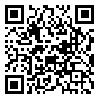Volume 13, Issue 3 (aAutumn 2018)
jmed 2018, 13(3): 260-267 |
Back to browse issues page
Neurogenic Inflammation Research Center, Mashhad University of Medical Sciences, Mashhad, Iran. , Shabnammhmmd@yahoo.com
Abstract: (5543 Views)
Abstract
Introduction: With the growing information technology, all aspects of life, including education and learning, have undergone a change. The use of modern educational tools and technologies plays a role in motivating students. Therefore, the purpose of this study was to investigate the most effective educational technologies from the viewpoints of medical students of the basic sciences of Mashhad University of Medical Sciences in 2017
Methods: This study was a descriptive survey study. The statistical population consisted of the 70 students of the basic sciences in the field of general medicine of Mashhad University of Medical Sciences. The sampling method was a census and the research instrument was a researcher-made and standard questionnaire. Content-related validity obtained by expert specialist and reliability was obtained using Cronbach's Alpha coefficient 0.8. Finally, the data were analyzed using SPSS software and descriptive statistics (frequency, frequency percent and chart).
Result: From view of medical students, the most effective educational assistance was software installed on mobile phones (42.1%) and the least effect was for flash cards (1%). The most software used by the students was Netter Anatomy Atlas Software and 3D-essential anatomy software. Educational figures and posters (14.9%), films (14.5%), models (11.1%), clinical scenarios (10.6%) and books (5.7%) were in the next category.
Conclusion: Considering, that most software is used by learners, these software programs are student-oriented and have student participation and interest.
Key words: Anatomy, education, technology, soft ware
Key words: Anatomy, education, technology, soft ware
Type of Study: case report |
Subject:
Medical Education
Received: 2018/03/29 | Accepted: 2018/05/19 | Published: 2018/12/17
Received: 2018/03/29 | Accepted: 2018/05/19 | Published: 2018/12/17
| Rights and permissions | |
 |
This work is licensed under a Creative Commons Attribution-NonCommercial 4.0 International License. |




